Hello, Magooshers. Mr. B here. Today I’m writing an article about a topic close to my heart: The International Baccalaureate (I.B.) Diploma Programme. Many years ago I was an I.B. student. In fact, I was one of the first 10 students in Tennessee to earn the I.B. Diploma. To say the least, it was an interesting experience. Sometimes it was interesting in a fun and exciting way. Other times it was interesting like that old Chinese curse, “May you live in interesting times.”

In this article, I’ll tackle some of the biggest questions students (and their parents) have about the I.B. Diploma Programme. This article is comprehensive, so it’s loooooong. Here’s a table of contents to help you navigate it:
Part I: What is the I.B. Diploma Programme?
Part II: How hard is the I.B. Diploma Programme?
Part III: How will an I.B. Diploma help me after high school?
Well, get comfy and buckle up. It’s time to learn all about the most rigorous, challenging, frustrating, and rewarding high school experience yet devised by man.
Part I: What is the I.B. Diploma Programme?
A long time ago (1968), in a country far, far away (Switzerland), a group of educators came together to create a new kind of high school experience. With a little seed money from the Ford Foundation and the United Nations Educational, Scientific and Cultural Organization (UNESCO), the first 12 I.B. schools opened in 1968.
The original goal of the I.B. Programme was to give the children of diplomats and other professionals a standardized education no matter where they moved in Europe or America’s big east coast cities. Over time, the number of I.B. schools grew. With growth came change. As I.B. spread to more countries, I.B. students could choose to learn different languages as part of their curriculum. Also, more colleges began accepting I.B. Diplomas in lieu of a traditional high school diploma. By the late 1980s, I.B. had spread just about all over the world.
Today, many countries (especially those in Europe) regard an I.B. Diploma as equivalent to their own country’s secondary school diploma. This is a great advantage to American I.B. students thinking about going to college oversees.
I.B. hasn’t been free of controversy during its 48 years of existence. Every few years a group or individual starts complaining about the I.B. Programme. Why? Well, they think I.B. is ‘Communist,’ ‘anti-American,’ or ‘anti-Christian’ because of its United Nations roots and focus on international education. To each their own, I guess.

Okay, now that you know a little bit about I.B., let’s get to the good stuff.
The Curriculum
First thing I want to mention is that there is a big difference between Pre-I.B. and I.B. Pre-I.B. is your freshman and sophomore years of high school. It’s a time when students learn a lot about what I.B. expects of them and take many challenging classes, including AP courses, to prepare themselves for I.B. When sophomore year ends, literally the moment the last day of school ends, I.B. begins. Why such a specific time? I’ll get to that in a bit. Or if you’re the impatient type, skip ahead to ‘Community, Action Service (CAS)’ to find out.
Okay, so it’s junior year. What can you expect?
The bulk of I.B. revolves around six classes you take during your junior and senior years of high school. Each class is chosen from a group. Selections may vary considering what your high school’s I.B. Programme offers. Also, courses are split into Standard Level (SL) or Higher Level (HL). I.B. recommends that a student takes 150 hours of instruction in an SL course and 240 hours of instruction in an HL course. In most American I.B. schools, HL courses are spread over two years to allow time for adequate instruction. For the purposes of this article, I am relating the bare bones information about SL courses. HL courses require roughly 30% more work. Don’t take my work for it: discover the official HL numbers for yourself.
One thing to note is that for all I.B. courses, the final exam is a combination of work you produce in class and the exam itself at the end of the year.
Group 1: Studies in Language and Literature
This is your I.B. English course. Throughout the course, you are expected to read and analyze 10 major works (aka novels), and write a variety of essays/responses. The final exam includes not only writing but also oral presentations.
Group 2: Language Acquisition
This is your I.B. foreign language course. It is equivalent to a 4th or 5th year foreign language course. The final exam is a combination of oral presentations and essays which ask you to produce various types of formal and informal writing.
Group 3: Individuals and Societies
This is your I.B. history/social sciences course. There are a variety of choices, so I won’t go into all of them. Expect college-level textbooks and frequent essays.
Group 4: Experimental Sciences
This is your I.B. science course. Most likely you will have a choice between Chemistry, Biology, and Physics. Expect college-level textbooks, frequent research essays, and research projects that you design and implement.
Group 5: Mathematics
This is your I.B. Math course. At SL, this course is a combination of second-year algebra, trigonometry, geometry, statistics, and introduction to calculus.
Group 6: The Arts
This is your I.B. elective course. Depending on what’s offered at your school, you can take an I.B. music, theater, visual arts, or film course. Throughout the course, expect projects along with maintaining a portfolio of relevant work.
If your school does not offer these courses (this was my situation), you can substitute a Group 6 course with an I.B. course from any other group.
At this point, you’re probably thinking, “Wow, that sure sounds like a lot of work. Is this really…”
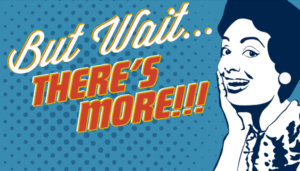
Creativity, Action, Service (CAS)
Ah yes, CAS, the ‘get your nose out of a book and do stuff’ part of I.B. In short, CAS requires you to do (and document) 150 hours of activity. How does it all break down? Let’s take a look.
Creativity (50 hours): These are your creative endeavors, such as playing music, painting, writing short stories, etc. It’s a fairly open-ended subject, so you’ll need to get approval from your school’s I.B. coordinator before starting your hours.
Action (50 hours): Things are going to get physical. Play a sport? That takes care of your 50 hours. Anything else? See your I.B. coordinator for guidance.
Service (50 hours): As the name implies, it’s time to get out there and help your community. If I had to do it all over again, I’d go straight to my local food bank and volunteer. Seriously, food banks are a great way to help people. So does organizing a blood drive at your school.
Remember when I wrote earlier that I.B. begins the second your sophomore year ends? You see, the moment summer break before junior year starts, you can begin working on CAS hours. Though filling up your usually lazy summer days this way may not seem too appealing, trust me on this one. Get your CAS hours done ASAP.
Extended Essay (EE)
Every I.B. class requires a ton of writing, yet I.B. has one more big curve ball to throw at you. The EE is a 4,000-word research essay based on a topic from one of your Group 1-6 courses. Just like in college, your teachers are ‘hands off’ as you work on this essay. Even so, you do get support from your I.B. coordinator, who provides guidance throughout the research, writing, and editing process.
Theory of Knowledge (ToK)
A long time ago philosophers like Socrates and Plato sat around all day and talked about life, the universe, and everything. In Theory of Knowledge you’re basically doing the same thing. Throughout your senior year, you get to sit with all the other I.B. students (and most likely your I.B. coordinator) and discuss the ‘big questions.’
Yes, there are a few papers to write, and a mandatory presentation. Yet considering everything else you’re required to do in I.B., ToK is small potatoes. And if your teacher’s into it, it can be a pretty fun class.
Part II: How hard is the I.B. Diploma Programme?
I once heard this great story about how people perceive difficulty. We go through our lives thinking everything is really hard. And it is. But after enough time, we start to look back and regard our worst trials as teens as ‘not that bad.’ Why does this happen? Over time, we become more competent, more resourceful. Of course, at 30-years-old, I think I.B. wasn’t so bad. I’ve had a lot of time to grow. But I just can’t pass on that confidence, those skills that they don’t (and can’t) teach in school. So for you, all I can offer are the facts of my experience, and a few tidbits of advice along the way.
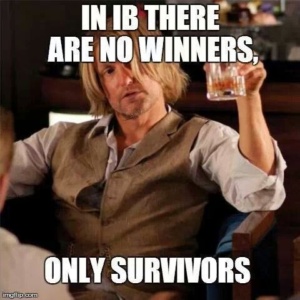
But yeah, I.B. is hard…really hard.
I.B. Courses
As touched upon in Part I, SL & HL courses are college-level courses. Think of them as AP courses with some key differences. The first is that some of the work you do throughout the year will be graded as part of your final exam. This score plus that from the exam at the end of the year determine your final score. The final score is awarded on a 1-7-point scale.
Also, I.B. courses aren’t ‘stand alone;’ the score you earn in each course influences whether or not you earn the I.B. Diploma. Every score is weighted equally, so you are going to have to work your hardest to improve your weaknesses.
Classwork: Let’s start with some good news. Unlike regular or even honors high school classes, I.B. courses more closely resemble what you would find in a college seminar class. There’s a lot of discussion and sharing of ideas. This privilege has a trade-off. Much of the traditional ‘work’ you’d do in class gets shifted onto you as homework. We’ll get to homework in just a bit.
Organization: Does your teacher want you to organize your work a certain way? If so, do it and don’t look back. Trust me, they know a lot more about organization than you. Also, in their careers they’ve dealt with plenty of students whose backpacks look like a bomb went off inside.
Homework: Just like in AP, I.B. courses have a lot of reading. Whether it’s a novel for I.B. English or 50 pages of a textbook for I.B. Economics, reading and taking notes will be the majority of your homework. If you want to be ready to participate in discussions, you need to know your stuff.
Homework Pro-Tip: If you have the chance your junior or senior year, sign up for a study hall. Honestly, it was the best decision I ever made as a high school senior. And when you get in there, don’t let a thing distract you from your work. Bring ear plugs if necessary. That may seem a little extreme, but using this time to finish a chunk of homework every day was a godsend.
Projects/Essays: There are a lot of them. It’s very likely, too, that you will have 2-3 projects going on at the same time for different classes. Here’s where having a planner will save your life. Write down everything in it, and get some different colored highlighters to mark key due dates.
Planner Pro-Tip: Planners can be used for more than just writing down due dates. Have a big project or paper? For each day leading up to the due date, set a completion goal. Doing this will help you make sure that nothing sneaks up on you. Also, by breaking up big projects, they will become more manageable and your stress level should stay at a low roar.
Expect the Unexpected: Things come up, whether in your personal life or something at school. For example, one of my I.B. teachers once sprung a seven-page paper on us simply because she forgot it was a requirement for our final score. Also, we had four days to write it. Hopefully nothing like will happen to you, but don’t be surprised if you have a few late nights doing work that you didn’t plan on.
A disclaimer: if you’ve taken Pre-I.B. courses in your freshman and sophomore years of high school, the increasing difficulty level has prepared you for I.B. Did you maintain good grades during this time? If so, you’re on the path to I.B. Diploma success.
Creativity, Action, Service (CAS) Hours
This is something you don’t want falling through the cracks. There is no worse feeling in the world than starting your senior year of I.B. and having zero CAS hours logged (this wasn’t me, but I knew a guy). As I mentioned in Part I, the sooner you get cracking on CAS, the sooner it will be over.
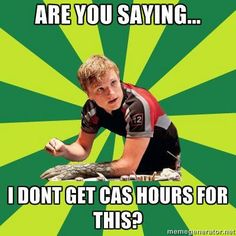
Kill Two Birds with One Stone: Believe it or not, there are plenty of activities that can count for two or all three categories. Let’s say you spent 70 hours total planning a blood drive at your school. You might believe that all that work only counts for 50 service hours. Not necessarily true! Let’s say you spent 20 of those hours designing a series of posters advertising the blood drive. There’s 20 creativity hours right there. Go you!
This is only one of many possible combinations you can try. If your school has had I.B. for a while, ask your I.B. coordinator and older I.B. students for ideas.
Extended Essay (EE)
In all, the EE takes about 75-100 hours to research, write, and edit. Something my school did was that when I was a junior, we chose our EE topic, researched, and wrote our first draft. This first draft was only 2,000 words, but it created a skeleton essay. During my senior year, I fleshed out my EE to 4,000 words through more research, writing, and editing. That final draft was the one that my I.B. coordinator mailed to Malawi for grading. (I had to look Malawi up on a map, but that’s where it went.)
EE Pro-Tip: Choose a subject that truly interests you. After all, that’s why you get a choice. If the topic had just been handed to me, I wouldn’t have put nearly as much work into it. Having choice can be a scary thing, but the rewards outweigh the risks when it comes to the EE.
I.B. Exams

I.B. exams are long tests. My last four I.B. exams lasted a cumulative 990 minutes. They’re difficult, too. I mentioned in one of my previous blog posts that the hardest test question I ever encountered was an I.B. exam question. Now, I’m not saying this to dissuade you from doing I.B. If you’ve done the work and maintained your grades, you are prepared to take these exams at the end of the year. So don’t freak out.
Everything Else
If you’re an I.B. student, it sometimes seems that the I.B. Diploma Programme is your life. But even for I.B. students, there is still the SAT/ACT, college applications, and asking your crush to the prom. And yes, you will have to make time for all of this as you tackle I.B.
Not Going Insane Pro-Tip: This is where family, friends, teachers, and even high school counselors come in handy. No man (or woman) is an island, and you need a support network. There will be times that you feel that all is lost, that you won’t get an essay done on time, or that your teacher will drown it in red ink. When you feel this way, find someone to talk to, say what you have to say, and listen to their advice.
Part III: How will an I.B. Diploma help me after high school?
For me, life after I.B. began in the summer of 2004. High school graduation had come and gone, but I, along with nine other I.B. students, were still waiting on the results of our I.B. exams. Then, one a day in late June, our I.B. coordinator called us to meet that evening…at the Sonic drive-thru next to our high school.
At twilight we gathered under the Sonic’s fluorescent lights. The diners around us were no doubt unaware of the momentous event that was about to happen. Our I.B. coordinator was last to arrive. In his hand he held a big manila envelope. “First of all,” he said, holding up the envelope, “you all got the diploma.”
We had done it! We felt more relief than excitement that evening. For me, it was a better moment than graduating high school. 12 years have passed since that night, and I think I’m finally ready to answer a key question held by I.B. students and their parents.
Before I get into the specifics, you should know that the long-term benefits of earning an I.B. Diploma aren’t things you can touch, see, hear, smell, or even taste. Unfortunately, there’s no secret handshake, no I.B. Club Card that gets you free upgrades on airline seats. Oh well. But there are benefits. Let’s talk about them.
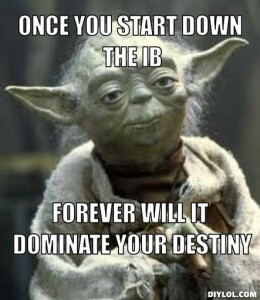
College Applications
Thinking about life after I.B. begins when you’re still in I.B. Like just about every other high school student, you’re going on college tours and making big decisions about where you want to spend the next four years of your life.
One advantage I.B. will give you during this crucial time is making you a better writer. College application essays will definitely look a lot easier if you’re cranking out essays every week for your classes. Also, with your enhanced organizational skills, keeping track of applications, and their respective due dates will seem much more manageable.
Working towards the I.B. Diploma has one other big advantage in the college admissions game. College admissions counselors love grit, and I.B. demands a ton of grit. Those two little letters say a lot of about you as a potential college student.
A disclaimer (This one is HUGE): The following isn’t meant to burst anyone’s bubble, but it’s worth stating upfront that being in the I.B. Diploma Programme doesn’t entitle you to anything. At 18, not getting into my 1st and 2nd choice colleges were nothing less than devastating. At the time, I really doubted that all my work and sacrifice had been worth it. It took a long time, and a lot of experience, to realize that my doubts were completely unfounded.
College
When I arrived at Vanderbilt University in the fall of 2004, I came in with a lot of earned hours from my I.B. and AP classes. It was really nice to skip the survey courses (imagine 300 students in a lecture hall) and jump into the ones that really interested me. It was a bit intimidating to be seated around a bunch of juniors and seniors, but really cool nonetheless.
If you should earn your I.B. Diploma, I think you’ll find, like I did, that that transitioning into college is much more manageable. Too many students completely bomb their first semester (or first year) of college because they can’t balance their work load with the freedom that comes with a college environment. I had plenty of fun in college, but work came first. That’s why I was there.
Don’ t get me wrong; I still struggled my first semester. I nearly failed Chemistry 101. But that experience taught me a lot about what I really wanted out of college. The next semester, I took courses that were a more natural fit with my interests. After that, all was well. I believe that the skills I learned in I.B. kept me level-headed during this time of transition. If I hadn’t done I.B., who knows what might have happened.
Post-College
Remember how I said that I.B. doesn’t entitle you to anything? Well, for me that was certainly the case when I graduated college in May 2008. At first everything seemed to be going well. I had a great internship overseas. About two weeks after I came home, though, the Great Recession happened. Over the next six months, I sent out about 150 job applications with zero replies. And when my dream job finally seemed within my grasp, I blew the second interview. “What was your dream job,” you ask? Well…all I can say is, “And ye shall know the truth, and the truth shall make you free.”
Anyway, it is my honest belief that I.B. saved me in this tumultuous time. I.B. equals grit, and I still had tons of it. I reevaluated my options, completed a two-year M.A. in Teaching program in 11 months, and went to work as a teacher for four years. In the classroom grit saved me yet again. Even now, the grit I developed in I.B. helps me every day as I write blog posts, workbooks, and travel itineraries for a living.
Final Thoughts
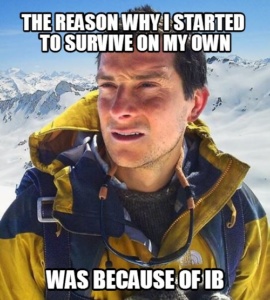
By telling you my story, I’m trying to convey the idea that what you get out of I.B. isn’t tangible. The best way I can describe it is the feeling that there isn’t a set of problems you can’t solve. No matter the curve balls life throws at you, you got this. That mindset is nothing short of priceless.
It is my sincere hope that by reading this article you’ve gained a little insight into I.B. Diploma Programme, the work involved, and the long-term benefits.
If you are a Pre-I.B. student about to start I.B., there is a lot of work in your future. That’s just the way it is. But how you approach the work, your mental mindset, is real determining factor in whether or not you earn the I.B. Diploma. In fact, it all boils down to a simple question:
It’s been a pleasure sharing my story with everyone. Till next time, Magooshers.





Leave a Reply